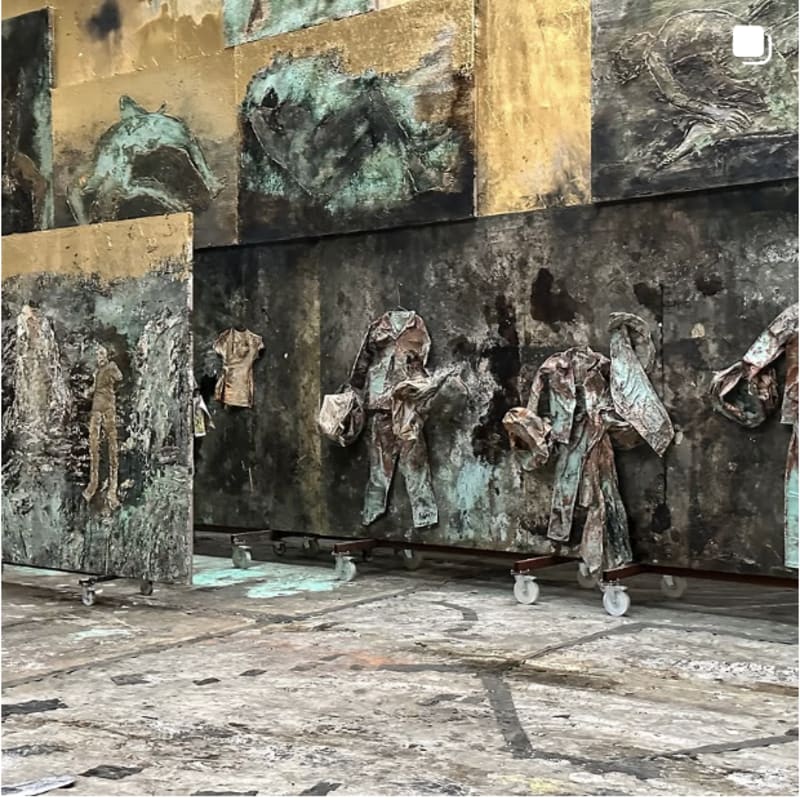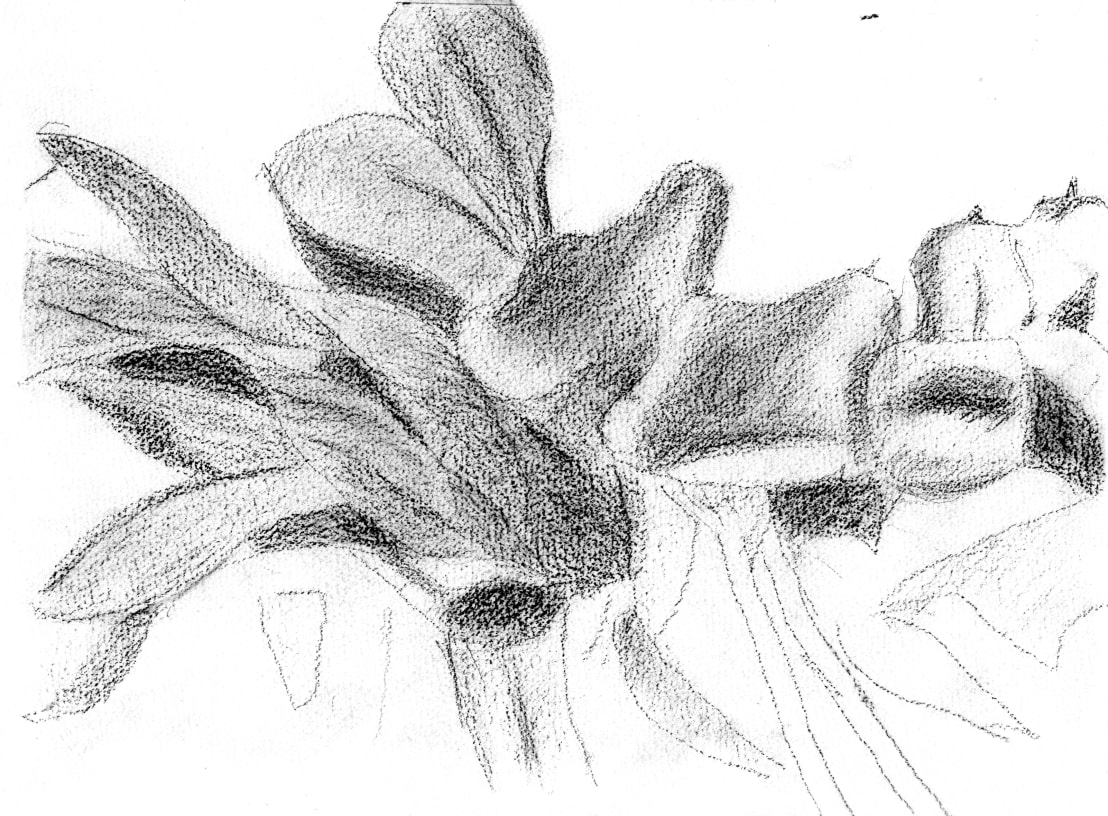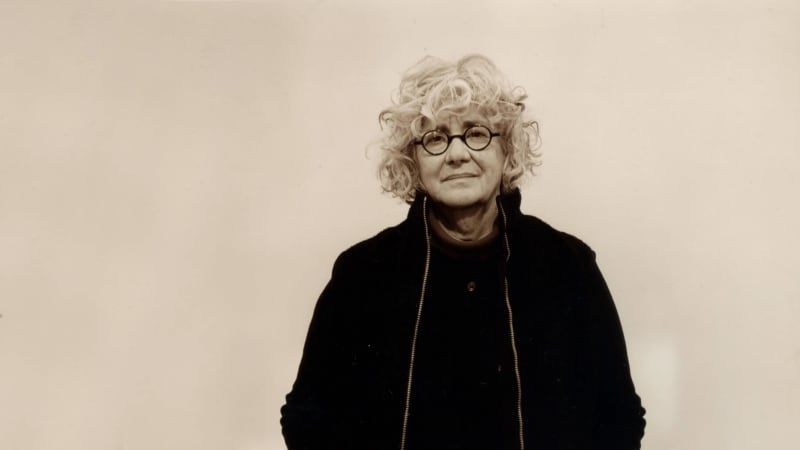Openings: Megan Rooney
By Laura McLean-Ferris
MEGAN ROONEY makes paintings, sculptures, poetry, and performance, though at present the Canadian artist’s signature works are large murals of softly bleeding colors that swim with bodily part-objects and coalescing faces. She produces these epic improvisations alone over a number of days on the blank walls of institutions and galleries. Lips and limbs materialize here and there, glimpsed in the depths of uncertain space, peeking from beneath washes of pale paint. Spidery eyes snap into focus, adorned with clumped-mascara lashes that spill wet gray streams of tears, close snoozily, or crumple gently with an injured expression. Rooney’s palette is mostly pastel and sugary throughout, signaling traditional femininity and North American suburbia—peach cobbler, baby showers—though occasional graphic streaks of grimy blackness suggest anxiety or offer comic relief. In Under the doggy clown hiss, a cloudy white, gray, lilac, and fawn mural the artist made on a large wall at the Museum of Modern Art in Warsaw in 2017, giant hands reach in from the painting’s perimeter. Resembling rubber gloves or Muppet paws, these appendages awkwardly communicate desire, grasping hesitantly at the bruised space of the painting or shyly waving: Hey, hello.
Single-handedly creating a large temporary mural requires some endurance on the part of the artist: working into the night to exhaust the limits of short installation periods, stretching one’s arms to reach far-off places. These large, gestural paintings also have brief lives. Murals, painting’s monumental form, are traditionally more suited to a long, public life, announcing the presence of a community, a place, or an ideology; by contrast, Rooney carries out marathon acts of painting, going all in on shows that are only temporary, giving form to figures that cannot help but announce their impending erasure.
For a 2018 painting on a wall of Paris’s Palais de Tokyo, Rooney acquired a license to operate a boom lift, or cherry picker, and bought a power sander. She used the sander to grind down layers of built-up paint, and thus was able to travel back in time through the creation of marks in her search for space and form. Rooney also applied this tool to her wall-hung paintings, for which she swapped out canvas on stretcher bars for the much-sturdier ground of industrial canvas on hardboard. The artist’s most recent large wall painting, Fire on the Mountain, 2019—the centerpiece of her solo exhibition at Kunsthalle Düsseldorf this spring—dramatized the creative cycle of layering, grinding away, and layering again. Warm in tone, almost inflamed, as the title would suggest, the painting nonetheless appeared worn down, even weathered. There were flattened areas of salmon pink and burnt sienna that suggested patch jobs and cheap repairs on a building, as well as smeared, wetter areas, which implied an accident with blood or barbecue sauce.
ROONEY SPENT her early childhood in Rio de Janeiro and still vividly recalls her mother’s tropical garden, planted with hibiscus bushes, and the view from her bedroom window of the Christ the Redeemer statue on Corcovado Mountain. When her family moved to Markham, Ontario, when she was seven, Rooney experienced the shock in part as a change in palette. Taupe, brown, black, and gray became affiliated in her mind with a new neatness and propriety in attitude. Brick and stucco. Tidy lawns. In defiance of this North American drabness, Rooney’s mother painted the entire exterior of their house flamingo pink, and the family became known locally as the “people who live in the pink house.” Rooney made her first mural at around the age of eleven, daubing outdoors on the flamboyantly bright walls of that same home.
Rooney’s painterly attunement to color manifests in her writing and poetry—which she performs as readings and uses as scores for exhibition-related performances—as well as in the reflective emails and letters she regularly sends to her friends and collaborators. In March 2016, one arrived for me from wintry Montreal, where she was writing “from a hunter green leather sofa, staring at my reflection in a giant flat screen tv and looking out at a landscape of brown, grey black, green-brown, shit brown, cream and frozen brown, white with brown—it goes on.” In her paintings, the palette suggests the coagulation of sweet and subdued femininity (colors that must be kept clean) with soil and stains. This precise combination engenders an air of exhaustion, subtly suggesting a lack of care for “nice” things or a poor fix for a bad situation: makeup on a bruised face.
This type of work insists on the apprehension of the world through the faulty apparatus of the body: its slapstick slips and spills, the limits imposed by subjective perception, the gaps in memory. It’s the same sense of corporeal compromise that makes itself felt in the gestural semi-figuration of painters such as Amy Sillman and Michaela Eichwald. “Old baggy root,” 2017–, is an ongoing series of quickly made portraits depicting faces Rooney knows or has simply seen. Those countenances, conjured from memory and portrayed with a limited watercolor palette, rarely articulate clear emotions, more often evincing shifting constellations of fleeting thoughts and ever-changing moods crystallized as patches of color on a face. Rooney’s sculptural works, primarily assemblages of found objects, differently evoke the weight and drag of a body. The base of Kaputt! Kaputt!, 2019, is a beaten-up oil barrel filled with concrete and painted in custardy creams and grays. A golf club, rammed into the cement while it was still wet, forms a spinal column and neck; the clubhead is dressed with a chamois cloth and a pink baseball hat. The figure carries three pink lumps of fabric behind her, like organs or gobs of flesh. Perhaps thanks to their tattiness and feeling of physical fatigue, Rooney’s works supply a blunt sense of liveness and pleasurable presence, a materiality missing from our experience of the world through images.
Looking at Rooney’s blossoms and washes of color, I translate them into arrangements of objects that I have seen. Tinted moisturizer on a bathroom tile. Soda bottles with stubbed-out cigarettes in them. A cut-and-shut car. Her work exists in a constant cycle of trashing and cleaning up, spilling and mopping up, damaging and fixing up, bearing pain and getting over it. I’m very fond of Agnes Martin’s paintings from the 1990s, named funny things like Happy Holiday and I Love the Whole World, with a lot of pale peach, duck-egg blue, and white in long horizontals. They take me to a moment when the sunlight in the distance was just so, as I looked up and out over a field, standing at a pleasant party holding something in my hand. It’s a memory I don’t think is mine, in which I have left my body for a moment. Rooney’s paintings have a similar sense of familiarity, but the body sticks awkwardly in place. The thing in your hand is melting, dripping; you’re squinting and sweating. The sun tenderizes everything around it, revealing soft vulnerabilities and states of disrepair.
















































































































































































